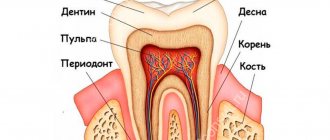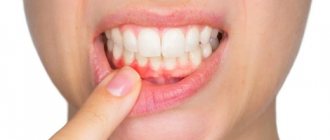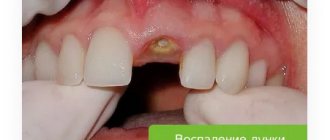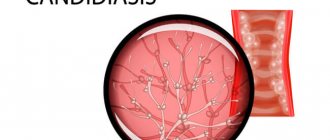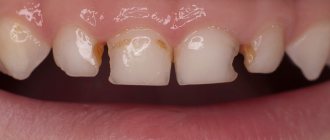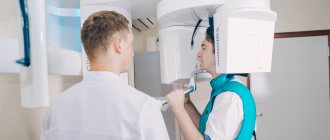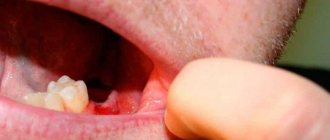Walking in the fresh air is useful at any time of the year, but still a long stay outside in sub-zero temperatures can sometimes unexpectedly lead to local hypothermia of the face and head. Often the consequence is an inflammatory process in the dental nerve.
In such cases, patients usually say that they “have caught a cold on the dental nerve.” Experts call this phenomenon “local hypothermia of the dental nerve.”
Inflammation in this case usually has nothing to do with the penetration of infection. The reason is directly related to the experience of severe hypothermia.
To understand the reason for the development of inflammation in the dental nerve after exposure to cold temperatures, you should first pay attention to the anatomy. The center of the tooth is the pulp.
The pulp is a soft tissue with its own system of blood vessels and nerves. It has a loose structure. Each pulp tissue performs a specific function. It is known that large nerves of the pulp have a connection with the root processes. If toothache occurs, it is always associated with the dental nerve in the pulp.
Why might this happen?
The reasons are obvious:
- Dental nerves are sensitive to cold.
- Prolonged exposure to wind on an unprotected face.
- Lack of headwear in cold weather.
- General hypothermia of the body.
Possible provoking factors should also be highlighted
- Development of caries.
- Tooth chips and injuries.
- Tooth infection.
- The use of low-quality fillings in dental treatment.
- Poor quality prosthetics.
Features of the disease
There is a widespread misconception about the safety of colds for an adult; most people disdain the need for bed rest and limiting exercise until complete recovery. When the first signs of ARVI appear: sore throat, nasal congestion, treatment should begin, ideally under the supervision of a qualified specialist. Complications after a cold are common: kidney and heart diseases. After the first signs, a cough, runny nose begins, the temperature rises, and the disease develops rapidly. Many suffer from a cold “on their feet”, doing their usual things, visiting public places, limiting themselves to taking modern medications that do not cure, but relieve symptoms.
ARVI is a threat to others; viruses live indoors for more than 7 hours. A visit to the dental office by a sick person is accompanied by the risk of infection of staff and visitors. Dental treatment during ARVI is a risk for the patient himself; the weakened body does not resist and is not protected from other infections and viruses.
What symptoms indicate a cold dental nerve?
Pain. Local hypothermia of the dental nerve is manifested by severe pain. It usually occurs unexpectedly without any mechanical impact.
In some situations, patients complain of pain in the ear, jaw, and temples. With temperature and mechanical influence, such pain may intensify.
Heat . Not in all situations, but it still sometimes happens that the inflammatory process in the pulp after hypothermia leads to an increase in body temperature. Usually it rises to a maximum of 37.5° C. If the temperature is higher, this may indicate general intoxication of the body.
The appearance of skin sensitivity . Sometimes pronounced redness appears on the face in the area where the inflamed tooth is located, associated with increased sensitivity of the skin in this area.
Patients may complain not only of pain when touching a “chilled” tooth, but also to the skin of the face in the approximate area of its location.
Treatment
You should contact your dentist when you experience pain in your teeth. The pain is of a fading nature, and the inflammatory process can progress. The dentist will examine the mouth and teeth and, having identified the cause of the pain, will prescribe treatment. Emerging and fading toothache can be relieved at home.
How to properly treat a chilled tooth nerve?
If the dental nerve is cold, you should not postpone a visit to the dentist, as the inflammatory process and pain will intensify over time, which will lead to dangerous negative consequences.
For temporary pain relief:
- Moisten a piece of sterile cotton wool with alcohol (another option is vodka) and apply it to the tooth. This will slightly suppress the inflammatory process and relieve pain. But it is important to avoid contact of the mucous membrane with the cotton wool to avoid burns.
- Add chlorhexidine (no more than 5 drops) to a glass of warm water from a kettle. The solution should be used to rinse the mouth to “pacify” inflammation.
- Use dried sage leaves in small quantities. Pour boiling water over them, let cool. After this, you can rinse your mouth with the resulting infusion.
Professional treatment
The treatment method for a cold dental nerve depends on the cause, the nature of the symptoms, the general well-being of the patient, the condition of the tooth, its pulp and oral mucosa. In case of severe complications, there is usually a need for urgent hospitalization of the patient.
If for now the symptoms are limited to acute pain, the dentist will provide emergency treatment to eliminate the inflammatory process.
If there are chips, other signs of mechanical damage to the tooth, or signs of caries, the diseased tooth is cleaned and filled.
In case of necrosis of the soft tissue of the pulp or its complete damage, surgical treatment and antibacterial therapy will be required after removal of the pulp.
Possible risks and complications
As a rule, the virus enters the body through the mucous membrane of the throat or nose, therefore the tissues of these organs become inflamed first. Since the treatment site is close to the source of infection, the virus can easily penetrate the tooth tissue along with saliva. It can slow down the recovery process and cause complications after procedures, for example:
- Sinusitis. Occurs when a virus or bacteria enters the maxillary sinuses. In the sinuses close to the eyes and brain, pus appears, which causes intoxication of the body. If left untreated, sinusitis can lead to meningitis, otitis media and sepsis.
- Otitis. Occurs when an infection enters the middle ear cavity and causes inflammation. Acute purulent otitis media can contribute to the development of labyrinthitis - the spread of infection to the inner ear. An unfavorable outcome of this disease can be complete hearing loss.
- Pneumonia. Pneumonia begins when an infection enters the respiratory tract. Treatment should not be delayed as the disease can be fatal. The consequences of advanced pneumonia include: acute respiratory failure, abscess, pulmonary gangrene, pleurisy, pleural empyema, obstruction, endocarditis, pericarditis, meningitis, pulmonary edema and sepsis.
- Meningitis. Through the circulatory system, a virus or bacteria can enter the brain and cause inflammation of its membranes. If treatment is delayed, the disease can cause problems with mental development in children or lead to complications such as deafness, epilepsy and hydrocephalus.
- Osteomyelitis. It develops when the infection enters the bone tissue through the bloodstream or infected surrounding tissue. The disease can lead to bone deformation, the appearance of tumors at the site of inflammation, pathological fractures, and ankylosis of the joints.
In order to reduce the risk of complications after dental treatment with fever, it is necessary to follow the doctor’s recommendations before and after the procedure, take medications, and monitor oral hygiene.
How to protect the dental nerve from hypothermia?
- During the cold season, use warm hats, scarves and outerwear with a high collar.
- In low temperatures and strong winds, it is advisable to cover your face with clothing.
- Do not use a thermos with hot water. Temperature changes may cause inflammation of the dental nerve and the appearance of an acute painful reaction.
Study the condition and appearance of your teeth, as well as the oral mucosa, regularly on your own. This way you can see suspicious changes in a timely manner.
If the third molar hurts
Very often, after a wind blows, or after hypothermia, a wisdom tooth begins to ache. This may be due to all of the reasons listed earlier. But sometimes this signals an exacerbation of pathologies that are characteristic directly of the third molar:
- eruption is too long, complex and not always correct: “eights” pass through the bone and touch the nerve endings, sometimes they rest against neighboring elements of the row, put pressure on them and destroy them, provoking vague pain sensations,
- pericoronitis: acute and often purulent inflammation of the gingival hood hanging over the “sage”, under which food debris and bacteria become clogged.
Content:
- When treatment is necessary
- When is it not recommended to treat teeth for a cold?
- High fever and toothache control
- What to do if you had to postpone your visit to the doctor due to a viral disease
Treatment of toothache during acute respiratory viral infections and acute respiratory infections has a number of features.
Due to the disease, a person’s immunity decreases, which means that the body may respond inadequately to any intervention. It is especially dangerous to carry out drainage and other invasive dental operations at this time. Therefore, dentists usually do not recommend coming for an appointment if you are not feeling well. The difficulty lies in the fact that with a runny nose or headache (and these are quite common signs of ARVI), it is difficult to sit for a long time in a doctor’s chair with your mouth open. But it is not always possible to postpone a visit to the dental center. If a doctor’s help is needed urgently, it is recommended to come for an appointment, regardless of the symptoms of a concomitant illness. The doctor will conduct an examination and tell you whether your teeth can be treated for a cold or whether therapy should be postponed.
Varieties
Today, there are two main classifications of tooth root inflammation - classification according to the place of origin of the inflammatory process and according to the form of the disease.
Based on the location of the inflammatory process, apical and marginal periodontitis is distinguished. Apical periodontitis forms in the area near the base of the root and the upper root part, marginal periodontitis begins in the gum area. Apical periodontitis, as a rule, occurs as a result of advanced pulpitis, while marginal periodontitis occurs as a result of trauma.
According to the form of the disease, dentistry distinguishes between acute and chronic periodontitis. The acute form of the disease is characterized by a sharp onset, intense pain (usually when pressing on a tooth and eating hot food), sometimes an increase in body temperature and swelling of the gums at the site of the pathological process and the formation of a fistula. Acute periodontitis can be serous or purulent. In the serous form, the pain is inconsistent; the purulent form is accompanied by a gradual increase in pain and the release of pus from the gums.
If you do not seek dental help at this stage, acute periodontitis can become chronic. In the chronic course of the disease, less pronounced symptoms are observed; as a rule, there is no increase in temperature (however, it can occur during an exacerbation). Mobility of the affected tooth appears, as well as a feeling of heaviness and swelling of the tooth from the inside.
Chronic inflammation of the tooth root occurs in three forms: fibrous, granulating and granulomatous.
The fibrous form of periodontitis can sometimes be detected only with the help of an x-ray or computed tomogram, since this form of chronic inflammation of the tooth root often does not manifest itself symptomatically. Elderly people often experience this form of periodontitis. With this form of the disease, the tissue around the tooth becomes pale pink, and the tooth itself may darken.
The granulating form is diagnosed more often than others. With this form, a channel forms in the gum through which pus comes out. Granulation tissue develops, which grows and can have a negative effect on the bone.
In the granulomatous form of chronic periodontitis, sacs filled with pus form on the gums. Granulomas appear at the apex of the tooth root, which separate the affected part of the tooth from the healthy part.
Ignoring chronic periodontitis can lead to a weakening of the body's immune system, resulting in a constant, low-grade inflammatory process.
